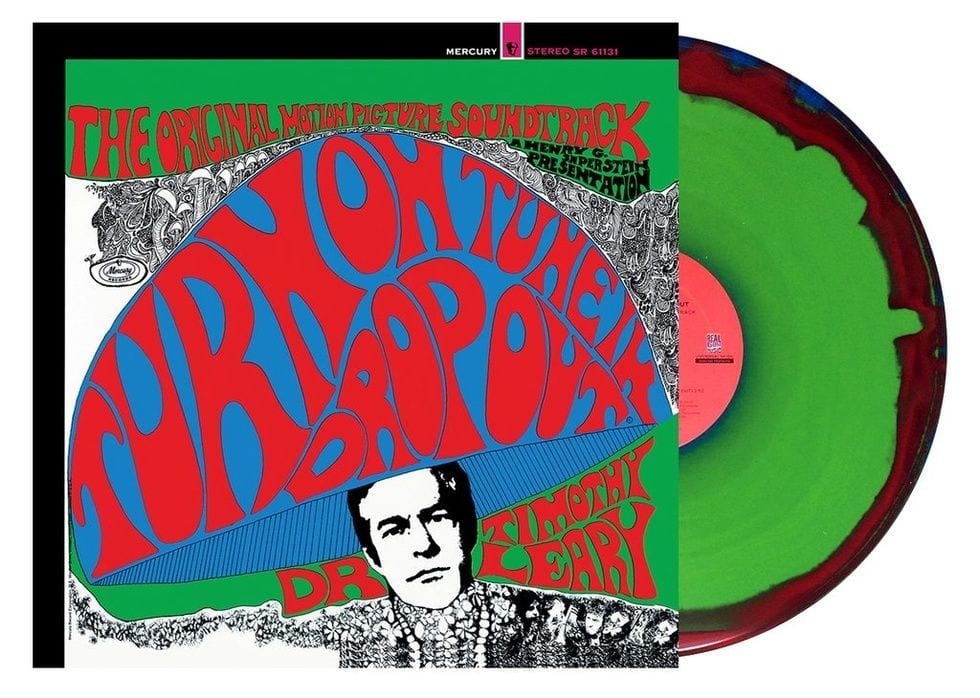
The soundtrack album for Turn On, Tune In, Drop Out resonates heavily to document and demonstrate Dr. Timothy Leary’s philosophy and influence in the mid-1960s. It’s at once a loose soundtrack taking a spoken-word ESP-Disk album recorded by Leary a year earlier and adding instrumental pieces, and a musical journey meant to accompany a five-part film of the same name (or is it, maybe that’s part of its mysterious allure – there was no film). Leary’s historical prominence is as mystical and philosophical on Turn On, Tune In, Drop Out, as the supposed nature of the album’s existence as a soundtrack.
Originally issued by Mercury Records in 1967, the soundtrack incorporated Leary’s cultural presence, his “teachings” and advocacy for LSD use, and historically presents a trip deconstructing the mind. Revisiting the sonic and guided landscape 42 years later for a special limited-edition reissue LP pressed on kaleidoscope vinyl by Real Gone Music takes you into the 1960s and the wide range of Leary’s cultural impact. Labeling the reissue a trip is equally too easy and unnecessary a pun and a limited range description for the musical qualities that accompany the Guide (Leary), the Voyager (Ralph Metzner), and the Divine Connection (Leary’s partner Rosemary Woodruff) as they explore the psyche and the human condition.
Leary’s commentary on and denouncing of conformity in American society and the problems in educational systems generated tremendous insight into the responses he earned from musicians and young Americans alike. The effect of his cultural presence and experiments in the mid-1960s often recognized primarily by his appearance at San Francisco’s Human Be-In in early 1967, is recreated and tangible by this soundtrack, possibly inferred in its capability when released of giving its listeners the communal gathering and interpersonal experience captured by the emerging hippie movement. The soundtrack additionally individualizes the process of attaining his mantra to “turn on, tune in, and drop out” through the solitary listening experience and the hypnosis in the Guide and transcendence of the Divine Connection. Forty-years later, this reissued version acts as more of a historical document, revealing the experience of the mid-1960s without necessary transferring the mind-altering application of Leary’s immediate relevance or advocacy of LSD as an enhancement.
The incorporation of Eastern and Western instrumentation places the soundtrack at the height of 1960s musical culture. It’s structure and loose approach is appealing, with the opening for the album in “Turn on, tune in, drop out” and the “Epilogue” featuring accessible and enticing interplay between the musical performers hired by producer Al Lam to accompany Leary’s spoken-word recitations by engineer David Hancock. Leary’s spoken-word recordings possibly originated at the Millbrook, where he and company conducted many of their mid-1960s experiments following his firing by Harvard. One can imagine the long-form looseness in Leary’s spoken-word guidance, but the music on the soundtrack truly demonstrates the intended results of “turning on, tuning in, and dropping out” and catapults the trip by Leary’s Guide into the unknown.
The visual accompaniment of Real Gone Music’s kaleidoscope vinyl reissue offers a tangible depiction – safely without necessitating any experimentation or enhancement for the trip. Where most reissues add outtakes or demos that break down or bolster the musical qualities of a finished album and its historical relevance, Real Gone Music has approached this album with a visual accompaniment recreating the tangibility of the LP and its medium. Colored vinyl editions often seem unnecessary for casual listeners and reserved solely for collectors, but this reissue offers the kaleidoscope red-green-blue as the revisited component for the album. The sleeve, labels, and music are recreated fully and enhanced colorfully by the vinyl. If there was a film Turn On, Tune In, Drop Out, it’s surely unnecessary 42 years later and the colorful quality pictured by the reissue vinyl creates its own refreshing interpretation of 1960s cultural history.

